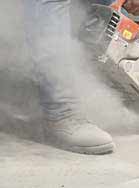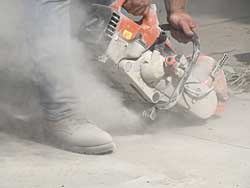
Insole Insights
"There's fungus and other sorts of nasty stuff that can happen to your feet when you're in the work zone."
- By Jerry Laws
- Jul 09, 2007
 Editor's note: You may not realize that a worker's shoes make him or her more productive, but Tom Votel makes a good case below for the proposition. And if good footwear and inserts can boost productivity, it stands to reason that poor footwear can harm it. Votel, President and CEO of Ergodyne (www.ergodyne.com, St. Paul, Minn.) discussed footwear's role in worker productivity during an April 13, 2007, conversation with Occupational Health & Safety's editor. Excerpts from the conversation follow.
Editor's note: You may not realize that a worker's shoes make him or her more productive, but Tom Votel makes a good case below for the proposition. And if good footwear and inserts can boost productivity, it stands to reason that poor footwear can harm it. Votel, President and CEO of Ergodyne (www.ergodyne.com, St. Paul, Minn.) discussed footwear's role in worker productivity during an April 13, 2007, conversation with Occupational Health & Safety's editor. Excerpts from the conversation follow.
I have associated your company with ergonomic products, not with footwear and foot protection. What's going on?
Tom Votel: Productivity and protection--ergonomics is in that mix somewhere. . . . The fundamentals of ergonomics are, is it where I need it when I need it? That's kind of primordial ergonomics, in a way. We see that as continuity with regards to our company, but we've pretty dramatically expanded beyond that.
[Footwear inserts are] a category we were in several years ago, and we elected to get out of the category because our product was not very interesting; it did not have the technology that we wanted. But this category kind of always fit. And we're always looking for specialty, kind of boutique areas we can go into. . . . This very much fits that angle. We decided to get back into the category because we worked with a designer who for 20-plus years has designed insoles and other related products for the extreme sports industries.
They had some really cool ideas that we thought were applicable to an industrial application because, of course, a lot of what somebody does on a half-pipe or somebody on a snowboard does, or somebody on a rollerblade does, or somebody jogging, running--those are pretty extreme situations. And there's still some fatigue and static stuff, but in terms of the active stuff, there's lots of technical knowledge that comes from that.
What we've done is, we've designed a line of three different footbeds.
Inserts, you mean?
Votel: Yes. They all have some similar features that are somewhat critical, and then they all have some differences. We're in the foot protection accessories business; we're not going to make steel-toed shoes.
It's for that worker who has an old pair of boots they want to improve the fit and function of--the foam they have in their shoe has completely compacted but the shoe is fine, or they went to a leather shop and got it fixed. Or somebody who has special needs, who is jumping off a baggage conveyor belt or they work for a railroad and they're jumping off a railcar onto a hard, rocky roadbed. . . .
Delivery personnel do that a lot.
Votel: A UPS delivery guy or somebody in construction, a tradesman who's jumping from a steel beam onto a concrete floor. You have that kind of worker, that more mobile worker, who has certain needs. And then you have the static worker: the worker who's building cars, building machines, or building electronics at Dell's facility in Texas, or a Hertz person standing there electronically swiping your credit card when you're dumping off your rental car.
There's all kinds of applications. You've got the static thing, and then you've got the more mobile deal. We've designed a line that addresses those [with a] deep heel and high arch. They're molded, unlike a flat, classic pharmaceutical solution. Those are fine for the Joe and Jane average consumer, but these are designed with much more technology in them. They cup the person's foot to keep it in position and provide support.
There's a ventilation system that maximizes air flow under their foot, helps them regulate temperature, etc. . . . There's fungus and other sorts of nasty stuff that can happen to your feet when you're in the work zone. Of course you've got dirt; you combine that with sweat and combine that with heat, and you have some issues. Having ventilation is really a nice benefit.
You mentioned a number of categories of workers who work outside. The heat also is pretty intense in some of those occupations.
Votel: There's no doubt. Again, those things all combine to create particular challenges [such as] contact dermatitis. You've got a lot of other sorts of issues. The other thing is, these are all antimicrobial-treated.
Are the ventilation and antimicrobial qualities good for the lifetime of the insert? Are they intrinsic to it?
Votel: Yes, they are. . . . You're not going to wash these. Usually [such protective qualities are lost] by washing. . . . It depends on your personal usage.
Normally, our magazine's foot protection articles talk about literal protection: protection from something that might slam into your foot. But you're talking about productivity.
Votel: That's correct. For the static worker, when you put in a nice insert that's built like this, it's kind of like an anti-fatigue pad for the feet. You understand the principle of what those anti-fatigue mats do. That foam, when you are on that . . . you're kind of actually floating on it. When you are, almost unconsciously balancing your foot, as that foam is swishing around your foot, you're using hydrostatic pressure. You're pumping blood from your lower extremities, your feet, back up your heart. So you get better blood exchange. That reduces fatigue and, obviously, related problems with pooling of the blood in the lower extremities. You have a benefit from that.
Obviously, shoes have some cushion in them. If this person has an anti-fatigue mat, that's going to help. This [insert] augments that process. Let's assume it is a worker who's on asphalt or on concrete. They're not going to have a nice anti-fatigue mat. Having some additional foam there to create that hydrostatic pressure and pumping of blood is a real good thing.
That's for the static worker. For the mobile worker or somebody jumping around, the way these are structured, there's foam at the heel. In regard to back injury and other, related problems, when somebody's jumping around from one surface to another, heel strike is a common challenge. The foams we're using are designed to dissipate that impact and shock so the worker doesn't take that up through their spinal column.
You make a good case for footwear's being able to promote productivity. Do you think you need to educate workers and safety managers about?
Votel: Yes. I think that's what we're trying to do here together. You've got static workers who could benefit from having a really nice insole that provides cushion and support and also can reduce fatigue. . . . I think there's all kinds of benefits that come from that.
The other thing is that providing a nice, stable, balanced insert can keep that worker from rolling their ankles, from doing a lot of things that can cause all types of preventable injuries. The other thing is that, when you have heel strike, you're talking about back injuries and other problems. Eighty percent of North Americans experience foot, knee, and back pain, and about 20 or 30 percent of Americans are experiencing that pain at any given time.
According to the American Academy of Orthopaedic Surgeons, your foot absorbs up to one a half times your own body weight while it's in motion. There's really a tremendous amount of pressure on your feet, and I don't think people really think about that.
You know, I trust, that OSHA by November will finally come out with a rule that says employers have to pay for their workers' PPE. Eight years ago, when they got started on this process, they said they would probably exempt footwear because it's such a personal piece of PPE. I don't really know what will be in the rule. My question is, employers in general soon may have to pay for footwear more than they're doing right now. So a good insert that would make their people more comfortable, more productive and maybe make their footwear last longer might be a good deal.
Votel: To be honest, I don't get the logic of that [exemption]. There's got to be a massive amount of data for steel-toed shoes, and why wouldn't they pay for those?
People can slough this off as just sort of a cushion and a personal preference, but if you look at podiatric data, there's clear science behind these things. There is a personal preference here, but there also is worker fatigue and other, soft issues that clearly contribute to making that worker much more productive and healthy. I don't think it's quite as clear as the respiratory standard for toluene; I get that. But go to an REI and look at people pulling out their inserts in their expensive shoes and putting in expensive, high-tech inserts. They have a very robust business doing that. And you've got workers spending eight, 10 hours plus a day on their feet. . . . You'll find [inserts] in ski boots, snowboard boots, and you'll also find them at high-end sporting goods outlets that are paying attention to their customers who are running, jogging, trekking, mountain climbing. We're bringing that technology for extreme sports to the worker.
A lot of PPE has gotten more stylish. And I guess there's some crossover from high-end sports in other ways. It makes sense to do it here.
This article originally appeared in the July 2007 issue of Occupational Health & Safety.